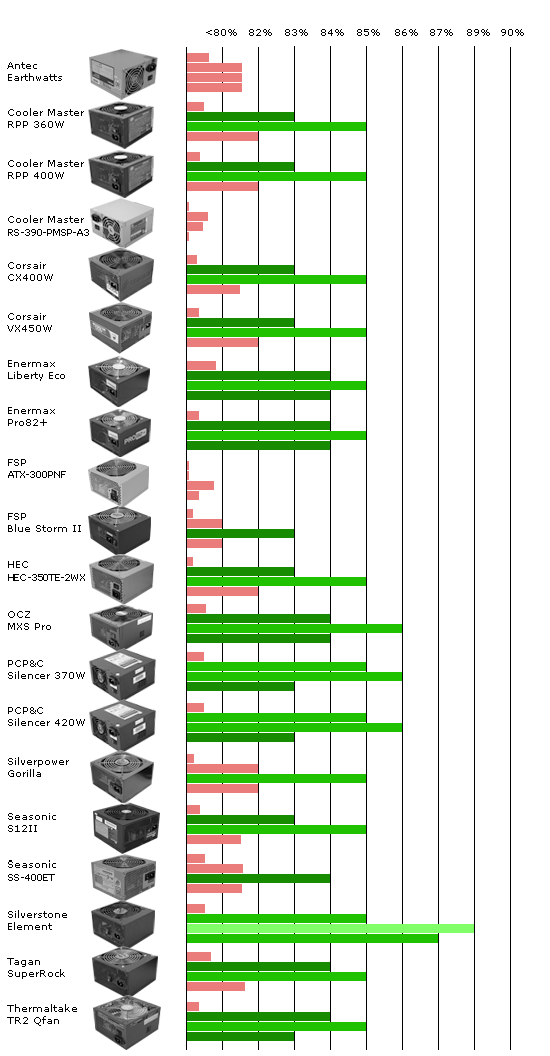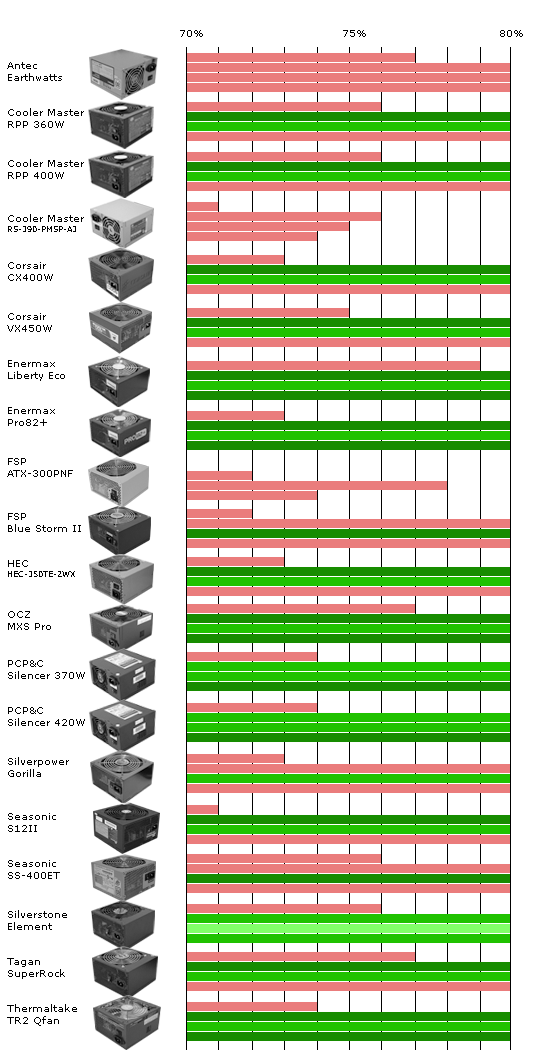300W to 450W: 20 Power Supplies on the Test Bench
by Christoph Katzer on December 31, 2008 6:00 AM EST- Posted in
- Cases/Cooling/PSUs
Efficiency Comparison
The problem most users do not realize today is that if you have lower wattage units you cannot really have the latest technologies inside since it just doesn't make sense. Fancy components and features costs money -- it doesn't matter if they are in an 800W or 300W unit. If you make a small power supply with very high quality features, the user will need to pay for it. The unfortunate truth is that there would be nobody out there willing to pay $150 for a 300W power supply because there are tons of options with prices starting as low as $20. The important thing is to know why you want to have a better quality product, which for most people today is the higher efficiency these units can deliver. If you have a price difference of $50 from your product of choice to a higher efficiency power supply with similar specs, then it will most probably not make any sense since you will need to run the power supply for several years 24/7 to overcome the initial investment.
We discussed this in our article about power consumption and why it is so important to know more about your PC and its components. With today's products we see 82% as a mark every high-end product should be able to reach, which is why we start from 82% with a green graph. Everything below will be red just to show you the efficiency wasn't that good. Don't be worried about the first graph of each power supply since that represents 10% load and no power supply that went through our hands was ever able to come even close to 80% with such a low load. This is why 80 Plus certification for example starts at 20% load. The second graph represents 20% load, the third 50% and the last represents full load. Here again, the more green bars a power supply has the more efficient it is. All of the efficiency results shown are with 230VAC for ease of comparison; efficiency will be slightly lower on 120VAC.

Since the manufacturers are primarily focusing on higher wattage power supplies with new technologies that bring better efficiency, we didn't expect any miracles today. However, some units again stand out from the crowd. Many of the power supplies reach 85% efficiency, which is a very good development. Power supplies from Enermax, OCZ, PC Power & Cooling, Silverstone, and Thermaltake show very good results. The Silverstone Element tops out at incredible 89% efficiency, which puts it at the top of the group a second time.
The following graphic shows the efficiencies below 80% which wasn't possible to include before. Please note the efficiency at 10% load of the FSP OEM unit is with only 61% not visible.











39 Comments
View All Comments
7Enigma - Wednesday, December 31, 2008 - link
That is a heck of a lot of work for this article and we appreciate it immensely! Between this article and the upcoming mid-range builders guide (I'm begging...please get it out asap) you have reaffirmed for me this is the #1 site.Thanks again.
TheDoc9 - Wednesday, December 31, 2008 - link
The breakdown of the cable connectors and the build quality descriptions were helpful. The power noise charts look useful as well.mino - Monday, January 12, 2009 - link
Copy that, one of the best PSU roundups around.magreen - Wednesday, December 31, 2008 - link
We definitely appreciate the roundup. It addresses our needs as consumers. I wish you'd add more info about the Antec Earthwatts 430 though... it's one of the most popular PSUs on the forums here and always shows up for cheap in the hot deals section, often bundled with an Antec case. Wish you'd give us more details on its efficiency, ripple, and your overall take. I don't think you actually said anything about its performance at all. Thanks!OddJensen - Monday, January 5, 2009 - link
Isn't there a Delta made version of the 430 as well?Christoph Katzer - Monday, January 5, 2009 - link
Yes which we didn't have.Christoph Katzer - Wednesday, December 31, 2008 - link
http://www.anandtech.com/casecoolingpsus/showdoc.a...">http://www.anandtech.com/casecoolingpsus/showdoc.a...Here's the original review from a year ago. Even though I didn't mention it in the conclusion I think you have a great comparison with the respective graphics towards the end. :)
donjuancarlos - Wednesday, December 31, 2008 - link
Thanks for this article. I am one of those who does modest OCing and no SLI, and this article was pertinent for me.eetnoyer - Wednesday, December 31, 2008 - link
No temperatures at load? I would think that temps at 100% load for each unit shouldn't be too much. Just as a worst-case thing.